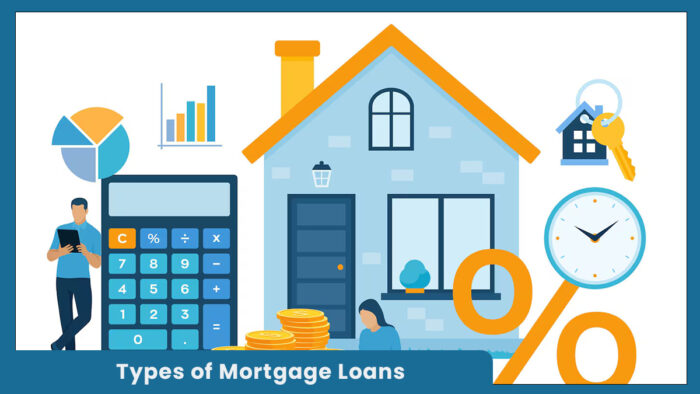Types of Mortgage Loans – There are different types of mortgage loans available, each designed to suit a variety of financial needs and personal situations.

The most popular mortgage option is a 30-year term. However, some fixed-rate borrowers go for a 15-year term to reduce the total interest paid and clear the loan sooner. Depending on the loan type, you may also find options like 20-year or 10-year terms.
1. Conventional Loans
Conventional loans are the most widely used type of home loan and are available through many different lenders. These loans follow specific standards that allow them to be sold to government-sponsored agencies such as Fannie Mae and Freddie Mac. For 2025, the loan limit for conventional conforming mortgages is $806,500 in most counties. In high-cost areas, the limit rises to $1,209,750.
One advantage of conventional loans is that you may be able to make a down payment as low as 3 percent. Another benefit is the wide availability of lenders, which gives you the flexibility to compare offers and choose the best rate. On the other hand, conventional loans usually require a credit score of at least 620 and a debt-to-income ratio below 36 percent. Also, if your down payment is less than 20 percent, you will need to pay for private mortgage insurance.
2. Government-Backed Loans
Government-backed loans are supported by federal agencies, which offer added security to lenders. If the borrower is unable to repay the loan, the government agency helps cover the loss. This safety net makes it easier for lenders to approve a wider range of buyers.
FHA Loans
FHA loans are insured by the Federal Housing Administration and are designed to be more accessible for buyers with lower credit scores. Before approval, the home must be appraised to ensure it meets FHA’s minimum property standards.
One of the main advantages of an FHA loan is that you may qualify with a credit score as low as 500, provided you can make a 10 percent down payment. If your score is 580 or higher, you may only need to put down 3.5 percent. FHA loans also allow a debt-to-income ratio of up to 50 percent for some borrowers.
However, there are some things to consider. FHA loans require mortgage insurance, which may last for 11 years or for the full life of the loan, depending on your down payment. Also, FHA loan limits tend to be lower than conventional loans. In 2025, the limit is $524,225 for most single-unit properties, but it can go up to $1,209,750 in more expensive markets. FHA loans are best suited for buyers who may have limited savings or less-than-perfect credit but still want to own a home.
VA Loans
VA loans are home loans backed by the Department of Veterans Affairs and are available to military service members, veterans, and certain eligible spouses who meet specific service requirements. One key advantage is that no down payment is required, which can make it easier to purchase a home. Another benefit is that you do not have to pay mortgage insurance, even if you are not putting any money down.
However, these loans are only available to military members, veterans, and qualifying spouses. Also, while the VA does not set a minimum credit score, most lenders will want to see a score of at least 620.
USDA Loans
USDA loans are supported by the U.S. Department of Agriculture and are designed for buyers in specific qualifying areas. There are also direct loan options for borrowers who fall below their local income limits. An advantage of USDA loans is that they do not require a down payment. Also, many eligible areas go beyond what most people think of as rural, including some suburban locations.
Things to consider include income restrictions, as these loans are meant for lower-income borrowers. There is also an annual fee of 0.35 percent of your remaining loan balance.
3. Jumbo Loans
Jumbo loans are mortgages that exceed the conventional loan limit of $806,500 and are used to finance more expensive homes. The main advantage of a jumbo loan is that it allows you to purchase a home that costs more than what Fannie Mae or Freddie Mac can cover. These loans can also offer competitive interest rates, depending on your credit and financial standing.
However, jumbo loans often require a larger down payment, sometimes up to 20 percent. Lenders will also want to see strong proof of income and cash reserves. While a conventional loan might require proof of six months’ reserves, a jumbo loan might require up to 18 months.
4. Fixed-Rate Mortgages
A fixed-rate mortgage has an interest rate that stays the same for the entire life of the loan. The main benefit is that your monthly payments remain predictable, making it easier to budget over the years. One thing to keep in mind is that if interest rates drop after you lock in your rate, you will need to refinance to take advantage of lower rates. Fixed-rate mortgages work best for buyers who plan to stay in their homes for a long time and want stable payments.
5. Adjustable-Rate Mortgages (ARMs)
Adjustable-rate mortgages start with a fixed interest rate for a set number of years and then adjust periodically based on market conditions. For example, a 5-year ARM keeps the same rate for the first five years before changing annually.
One advantage of ARMs is that they usually start with a lower rate, which can help buyers qualify for a larger loan or keep payments lower in the early years. However, once the fixed period ends, the interest rate can increase, which may lead to higher monthly payments. ARMs are a good choice for buyers who expect to move, sell, or refinance before the rate starts adjusting, or who are confident they can manage higher payments if needed.



